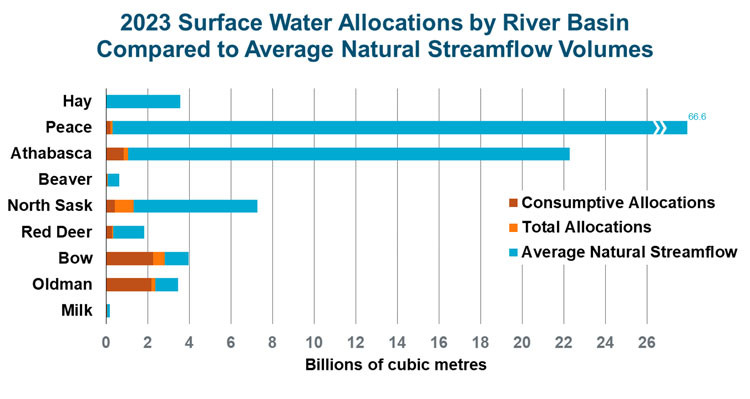
News Release: Removing holdbacks threatens already overdrawn Alberta rivers
April 9, 2025
- •
- •
- •
Last Friday, the Alberta government announced it would be removing holdbacks on water licence transfers, a move that could further degrade Alberta’s rivers, many of which are already intensely used and overdrawn.
“Eliminating conservation tools like holdbacks to maximize water availability in the near-term amounts to stealing from our futures,” says Kennedy Halvorson, a conservation specialist with Alberta Wilderness Association. “If we want these rivers to reliably provide fresh, clean water for the next generations, we need to recognize their ecological limits and live within them. We all rely on rivers; their health is our health.”
Holdbacks are one of the few tools available within the Water Act to restore balance without
impacting current users. They have been authorized since 1996, their use re-emphasized in 2006 following the recognition that many southern rivers had been overallocated; the Alberta government had licensed out more water for use than what was sustainable for the river’s health and closed the basins from new licences.
The stated purpose of holdbacks since has been to “help increase the flows of highly-allocated rivers by a small amount, or at least help offset increases in water use by the new licence holder.”
If unaddressed, the long-term impacts of diverting and using too much water from rivers can cause them to degrade and even dry up, as they no longer have the flows necessary to sustain their ecosystems, structure, and function. This threatens all livelihoods within the watersheds.
The Alberta government recognizes (but doesn’t require) that rivers should retain at least 85 per cent of their natural flow at any given time to remain healthy. However, in recent dry years, water users within overallocated basins like the Oldman and Bow consumed more than half the natural flow, demonstrating the urgent need to reduce allocations and overall use in these watersheds.

Graph © Alberta Environment and Protected Areas. Accessed April 7, 2025 from Drought – Water allocation and apportionment | Alberta.ca.
Where licensed volumes exceed 15 per cent of the natural flow, Water Conservation Objectives (WCOs) can be established through a public planning process. WCOs reflect the minimum flows required in the rivers to avoid an unacceptable decline in aquatic ecosystems, species, and water quality.
The Auditor General’s 2024 report on surface water management found that the government lacks water conservation objectives in most basins, is unaware if existing water conservation objectives work, and generally “lacks effective processes to manage surface water allocation and use.” In the basins with WCOs, Alberta regularly fails to meet them.
Considering the current state of Alberta’s rivers and watershed management, it’s alarming that the government now considers holdbacks “unnecessary.” The province needs methods to retain more water within rivers to prevent further ecosystem degradation and loss, as well as a looming water crisis.
At a time when climate change is increasing water insecurity, we need to protect our rivers. We need to leave enough water, not only for the aquatic environment and species, but also for human health.
Removing holdbacks is a step in the wrong direction for Alberta’s watersheds. Alberta Wilderness Association implores the provincial government maintain holdbacks and establish other mechanisms to address Alberta’s overallocated river basins.
For more information, contact:
Kennedy Halvorson, conservation specialist
(403) 283-2025, cs1@abwild.ca
Read AWA’s full letter to Environment and Protected Areas here.